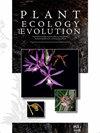Taxonomic description and pollination ecology of Cyrtorchis okuensis (Orchidaceae, Angraecinae), a new species endemic to the Cameroon Volcanic Line
IF 1.1
4区 生物学
Q3 PLANT SCIENCES
引用次数: 1
Abstract
Background and aims – A recent taxonomic and molecular study of the genus Cyrtorchis revealed three new species. Here, we describe one of these new species, endemic to the Cameroon Volcanic Line (CVL), and compare it to its closest relatives. Its conservation status is provided along with detailed information on its ecology and reproductive biology.Material and methods – A detailed examination of 21 herbarium specimens was performed using standard practices of herbarium taxonomy. The conservation status of the new species was assessed using the IUCN Red List Categories and Criteria. Furthermore, we investigated the reproductive biology of the new species in an easily accessible subpopulation in Cameroon and tested the hypothesis of hawkmoth pollination in the genus Cyrtorchis. Key results – The newly discovered species, here named C. okuensis, is restricted to the montane forest (1600 to 2500 m elevation) of the CVL and is currently assessed as Near Threatened (NT). Among angraecoid orchids in which hawkmoth pollination is recorded (~16 species), C. okuensis has the shortest nectar spur (19–40 mm). In situ observations revealed hawkmoths with short proboscis of the genus Hippotion (H. celerio, H. eson, and H. osiris) as the main pollinators. The rate of pollination and fruiting under natural conditions was low and among the 448 surveyed flowers only 38.8% (174/448 flowers) had their pollinia removed, 19% produced fruits (87/448 flowers), and 16% (70/448 flowers) set mature fruits. Conclusion – Cyrtorchis okuensis is clearly differentiated from C. submontana by its longer and wider floral bracts, longer anther caps, and wider triangular dorsal sepal.喀麦隆火山线特有新种奥库兰的分类描述及传粉生态学研究
背景和目的-最近对Cyrtorchis属的分类和分子研究发现了三个新种。在这里,我们描述了喀麦隆火山线(CVL)特有的这些新物种之一,并将其与最近的亲戚进行比较。文中还详细介绍了其生态学和生殖生物学的保护状况。材料和方法。采用植物标本馆分类学的标准方法对21个植物标本馆标本进行了详细的检查。根据国际自然保护联盟红色名录的分类和标准对新物种的保护状况进行了评估。此外,我们在喀麦隆一个容易接近的亚种群中调查了该新种的生殖生物学,并验证了Cyrtorchis属的飞蛾授粉假说。新发现的物种,这里命名为C. okuensis,仅限于CVL的山地森林(海拔1600至2500米),目前被评估为近危(NT)。在记录有飞蛾授粉的桔梗兰(约16种)中,okuensis的花蜜刺最短(19 ~ 40 mm)。现场观察发现,主要传粉者为短喙飞蛾属(H. celerio, H. eson和H. osiris)。自然条件下的授粉和结果率较低,在调查的448朵花中,只有38.8%(174/448)的花去了花粉,19%(87/448)的花结果,16%(70/448)的花结果成熟。结论-奥库石竹的花苞片更长更宽,花药帽更长,三角形背萼片更宽,明显区别于奥库石竹。
本文章由计算机程序翻译,如有差异,请以英文原文为准。
求助全文
约1分钟内获得全文
求助全文
来源期刊

Plant Ecology and Evolution
PLANT SCIENCES-
CiteScore
2.20
自引率
9.10%
发文量
27
审稿时长
>12 weeks
期刊介绍:
Plant Ecology and Evolution is an international peer-reviewed journal devoted to ecology, phylogenetics and systematics of all ‘plant’ groups in the traditional sense (including algae, cyanobacteria, fungi, myxomycetes), also covering related fields.
The journal is published by Meise Botanic Garden and the Royal Botanical Society of Belgium.
 求助内容:
求助内容: 应助结果提醒方式:
应助结果提醒方式:


